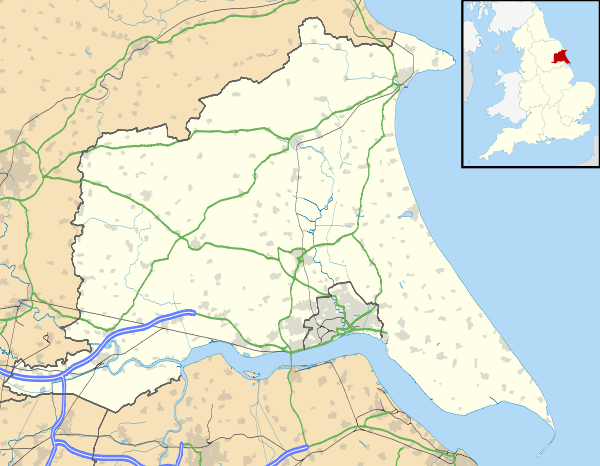RAF Melbourne
| RAF Melbourne | |||||||||||||||||||
|---|---|---|---|---|---|---|---|---|---|---|---|---|---|---|---|---|---|---|---|
| IATA: none – ICAO: none | |||||||||||||||||||
| Summary | |||||||||||||||||||
| Airport type | Military | ||||||||||||||||||
| Operator | Royal Air Force | ||||||||||||||||||
| Location | Seaton Ross | ||||||||||||||||||
| Coordinates | 53°52′04″N 000°50′19″W / 53.86778°N 0.83861°W | ||||||||||||||||||
| Map | |||||||||||||||||||
 RAF Melbourne Location in East Riding of Yorkshire | |||||||||||||||||||
| Runways | |||||||||||||||||||
| |||||||||||||||||||
RAF Melbourne was a Royal Air Force station during the Second World War. Located 5 miles to the South-west of Pocklington, Yorkshire, England. The nearest village is Seaton Ross.
History
East Common just outside the village of Seaton Ross was requisitioned for use as a grass airfield in November 1940. In late 1940 the airfield was used by Armstrong Whitworth Whitleys of 10 Squadron as a relief landing ground for RAF Leeming. The airfield soon closed for re-development as a standard Bomber Command airfield with three concrete runways and three hangars.
The first user of the re-built airfield was again 10 Squadron but by this time operating the Handley Page Halifax four-engined heavy bomber, little time was wasted before the aircraft were used on operational sorties from Melbourne. The squadron continued with operation until March 1945 and lost 109 aircraft on operations.
Melbourne was unusually equipped with FIDO fog dispersant system. This made the airfield popular diversion airfield for other squadrons returning from operations to Yorkshire.
In May 1945 the airfield was transferred to RAF Transport Command and 575 Squadron moved in with the Douglas Dakota. The squadron only stayed for a few months operating transport flight to and from continental Europe. With the departure of the Dakota a number of specialised Flights used the airfield for six months but by the middle of 1946 the airfield was no longer used for flying.
RAF units and aircraft
| Unit | Dates | Aircraft | Variant | Notes |
|---|---|---|---|---|
| No. 10 Squadron RAF | 1942–1945 | Handley Page Halifax | II converted to III from 1944 | Four-engined heavy bomber. |
| No. 575 Squadron RAF | 1946 | Douglas Dakota | Twin-engined transport. | |
| No. 1510 Flight RAF | 1945–1946 | Airspeed Oxford | Blind approach training flight | |
| No. 1552 Flight RAF | 1945–1946 | Airspeed Oxford Avro Anson |
Blind approach training flight | |
| No. 1553 Flight RAF | 1945 | Airspeed Oxford | Blind approach training flight | |
| No. 1554 Flight RAF | 1945 | Airspeed Oxford | Blind approach training flight |
- No. 4 Group Communication Flight (1945–1946)
- No. 91 Maintenance Unit (1949–1954)
Current use
The airfield is now home to York Raceway running drag racing throughout the summer. The farm on the North Eastern side of the site still uses the main East/West runway for his single prop aeroplane.
References
- Jefford, C.G. (1988). RAF Squadrons. Airlife Publishing Ltd. ISBN 1-85310-053-6.
- Delve, Ken (2006). The Military Airfields of Britain - Northern England. The Crowood Press. ISBN 1-86126-809-2.
- Sturivant, Ray (2007). RAF Flying Training and Support Units since 1912. Air-Britain. ISBN 0-85130-365-X.
External links
| Wikimedia Commons has media related to RAF Melbourne. |
